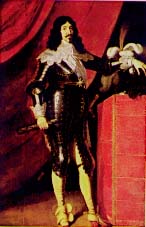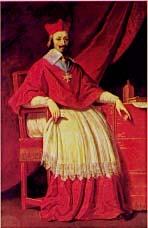|
King Louis XIV
 Louis XIV's parents, King Louis XIII and his wife Anne of Austria, hated each other. Their marriage remained unconsummated for at least four years; it was 23 years before their first child, Louis, was born in 1638. Apparently encouraged by this success, the royal couple produced another son, Philippe, in 1640.
Louis XIV's parents, King Louis XIII and his wife Anne of Austria, hated each other. Their marriage remained unconsummated for at least four years; it was 23 years before their first child, Louis, was born in 1638. Apparently encouraged by this success, the royal couple produced another son, Philippe, in 1640.
When young Louis was four, his father fell gravely ill with tuberculosis. Knowing that he was about to die, the king ordered that his eldest son be baptised (which normally would have taken place when the prince was seven). At the ceremony the boy was given the name Louis Dieudonne, or "Gift of God," because his birth had seemed so miraculous. Afterward he was brought to his father's deathbed. "What is your name?" Louis XIII asked.
"Louis XIV," the little boy replied.
"Not yet, not yet," said the king. But less than a month later he died, and his four-year-old son did indeed become King Louis XIV of France.
A Glorious Reign
 Cardinal Mazarin died in 1661, when Louis XIV was 22 years old. From that time on, Louis XIV was the sole ruler of France. He reigned for 72 years, longer than any other ruler in European history. Under his leadership France became a world power and a leader in the arts. He was an absolute monarch, as expressed in the famous quote attributed to him, "L'etat c'est moi" (I am the state). Identifying himself with Apollo, the Greek god of the sun, Louis XIV came to be called "the Sun King."
Cardinal Mazarin died in 1661, when Louis XIV was 22 years old. From that time on, Louis XIV was the sole ruler of France. He reigned for 72 years, longer than any other ruler in European history. Under his leadership France became a world power and a leader in the arts. He was an absolute monarch, as expressed in the famous quote attributed to him, "L'etat c'est moi" (I am the state). Identifying himself with Apollo, the Greek god of the sun, Louis XIV came to be called "the Sun King."
Today Louis XIV is perhaps best remembered as the king who built Versailles. When he became king he inherited several palaces, including the Fontainebleau and the Louvre. But after visiting the beautiful home of his minister, Nicholas Fouquet, he decided to build something even more magnificent.
He moved his court to the little village of Versailles, where he owned a quaint hunting lodge. First he improved the grounds with lavish gardens, sculptures, terraces, a lake, a zoo, and 1,500 fountains. In 1668 work started on the main chateau. The old buildings were surrounded by grand new ones designed by Louis Le Vaux and Francois Dorbay. Francois Mansard created the opulent Hall of Mirrors.
Smaller palaces were added nearby, including Marly-le-Roi, the Grand Trianon, and the Petit Trianon. The entire project cost 66 million livres.
After Louis's death, Versailles was used as a royal residence by his great-grandson Louis XV. The Sun King's great-great-great-grandson Louis XVI also lived there, along with his wife Marie Antoinette. Badly damaged in the French Revolution, the palace was restored by subsequent rulers and eventually became a museum, which it remains to this day.

|